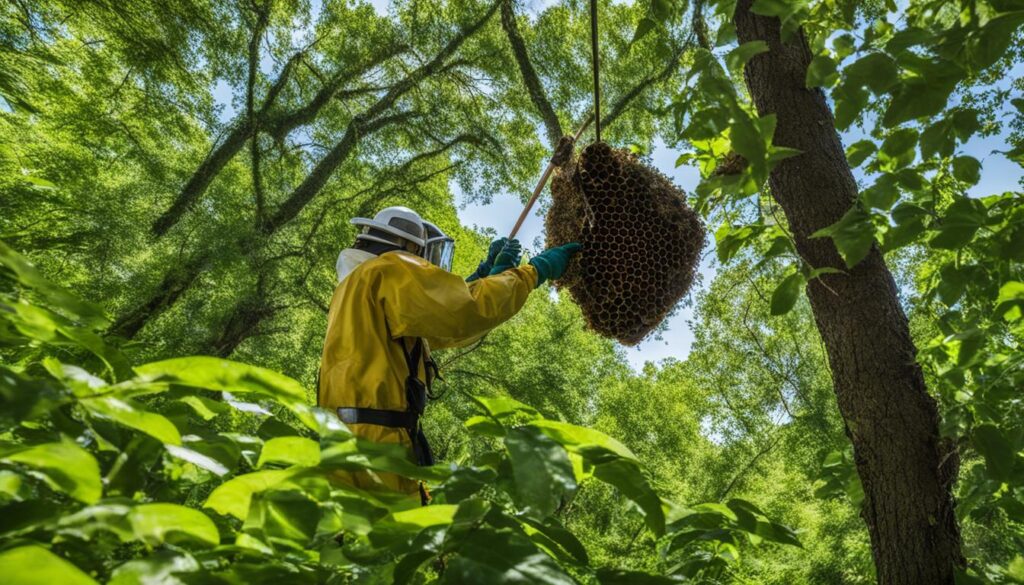Ground hornets can be a nuisance and a safety hazard in your yard. Their painful stings can cause allergic reactions and pose a threat to you and your family. However, with the right approach and precautions, you can safely eliminate ground hornets from your property. In this article, we will provide you with valuable tips and tricks to help you get rid of ground hornets safely.
Key Takeaways:
- Wear protective clothing when dealing with ground hornets to avoid stings.
- Professional removal services are recommended for large or challenging hornet nests.
- Insecticides specifically designed for stinging insects are effective in eliminating hornet nests.
- DIY hornet traps can be an effective way to reduce hornet numbers in your yard.
- Prevent hornet nests by removing attractants and sealing entry points to your home.
When to Call Professional Hornet Nest Removal Services
If you’re dealing with a large or challenging hornet nest, it’s highly recommended to call professional hornet nest removal services. These experts have the necessary equipment and expertise to safely remove the nests, especially if they are in hard-to-reach areas. This is particularly important for individuals allergic to wasp or bee stings or those who don’t have the appropriate equipment to handle the removal process.
Professional hornet nest removal services offer the safest way to eliminate hornet nests and ensure the well-being of both you and your property. Their experience allows them to assess the nest’s size, location, and species, determining the most effective and efficient removal method.
By entrusting the task to professionals, you can have peace of mind that the hornet nest will be safely and thoroughly removed, reducing the risk of stings and minimizing the chances of a re-infestation.
When it comes to large or challenging nests, attempting to remove them yourself can be dangerous and ineffective. Therefore, contacting professional hornet nest removal services is the smartest choice to ensure a swift and successful removal process.
How to Safely Approach a Hornet Nest
When attempting to remove a hornet nest yourself, it is essential to take the proper protective measures. Approach the nest at night when hornets are less active and more likely to be inside the nest.
Wear protective clothing like boots, coveralls, heavy gloves, and veiled headgear to prevent insect stings. Tape down your collar and the cuffs of your pants and sleeves to create a barrier. It is crucial to be cautious and avoid any sudden movements that may provoke the hornets.

Using Chemical Repellents and Insecticides
If you’re looking for the most effective method to eliminate a hornet nest, using specialized insecticides is the way to go.
It is important to spray the nest at night when the hornets are less active. This increases the effectiveness of the treatment and minimizes the risk of being stung.
To ensure your safety during the removal process, it is crucial to wear protective clothing. This includes long pants, a long-sleeved shirt, socks, gloves, and goggles. These items will provide a barrier between you and the hornets, reducing the risk of stings.
When using the insecticide, carefully follow the instructions on the spray can. Make sure to spray the nest from a safe distance to minimize the chance of disturbing the hornets. Additionally, exercise caution to prevent the wind from blowing the spray back towards you.
By using chemical repellents and insecticides in combination with protective clothing and proper application techniques, you can effectively eliminate hornet nests from your property. Remember, your safety is paramount, so always take the necessary precautions.
DIY Hornet Traps and Their Effectiveness
When it comes to reducing the number of hornets in your yard, DIY hornet traps can be an effective solution. One method involves creating a homemade trap using everyday items such as a plastic bottle, sugar, vinegar, dish soap, and even some meat. The combination of sugar and vinegar serves as an irresistible bait, attracting the hornets into the trap. Once inside, the dish soap prevents them from escaping.
To create your DIY hornet trap, start by cutting the top third of a plastic bottle and flipping it upside down. Then, mix a solution of sugar, vinegar, and some meat (if desired) and pour it into the bottom half of the bottle. Connect the two parts of the bottle, ensuring the opening of the inverted top is aligned with the liquid bait.
Hang the trap in an area with visible hornet activity, away from high human traffic areas. It’s essential to keep in mind that DIY traps may not completely eliminate hornets from your yard, but they can significantly reduce their numbers when used aggressively and strategically.
Preventing Hornet Nests and Attractants
To prevent hornet nests from forming around your home and yard, it’s crucial to eliminate potential attractants that might entice these stinging insects. By taking a few simple precautions, you can significantly reduce the risk of hornets building their nests in close proximity to your living areas.
Keep Your Garbage Cans Covered
One common attractant for hornets is uncovered trash cans. Hornets are attracted to the food and organic waste present in garbage, making it crucial to keep your outdoor trash cans securely covered at all times. By doing so, you can prevent these stinging insects from viewing your garbage as a potential food source, ultimately discouraging them from nesting nearby.
Remove Flowering Plants
Hornets are particularly drawn to flowering plants, as they provide a readily available source of nectar. To reduce the appeal for hornets, remove any flowering plants in your yard that may attract these insects. Instead, opt for non-flowering plants or varieties that are less attractive to hornets.
Eliminate Stagnant Water
Stagnant water sources, such as birdbaths or puddles, can attract hornets. To avoid this, ensure that any stagnant water in your yard is promptly dried up or removed. By eliminating these water sources, you can discourage hornets from settling in your vicinity.
Seal Cracks and Crevices
Hornets can easily gain access to the inside of your home through small cracks or crevices in the exterior walls. To prevent this, carefully inspect and seal any potential entry points. By sealing off these openings, you significantly reduce the chances of hornets establishing nests inside your home.
Remove Untreated Wood and Stumps
Untreated wood and stumps can serve as attractive materials for hornets to build their nests. To minimize the risk, remove any untreated wood or stumps from your property. By doing so, you eliminate potential nesting sites and make your yard less appealing to these stinging insects.
By following these preventive measures, you can effectively reduce the likelihood of hornets building nests near your home. By eliminating attractants such as uncovered garbage cans, flowering plants, stagnant water, and untreated wood, you create an environment that is less appealing to hornets. Remember, taking preventive action today can help you avoid future encounters with these potentially dangerous insects.
Conclusion
To effectively get rid of ground hornets from your yard, it is crucial to follow the right methods and precautions. If the hornet nest is large or challenging, it is recommended to rely on professional hornet nest removal services. Their expertise and specialized equipment ensure a safe and efficient removal process.
If you decide to tackle the problem yourself, ensure you wear proper protective clothing, such as boots, coveralls, heavy gloves, and veiled headgear. Taking the right precautions will help prevent painful hornet stings and reduce the risk of allergic reactions.
The most effective methods for eliminating hornet nests include using insecticides specifically designed for stinging insects and implementing DIY hornet traps. By using these products strategically and aggressively, you can significantly reduce the number of hornets in your yard.
Additionally, it is important to eliminate nest attractants around your home and yard. Keep outdoor trash cans covered, remove stagnant water sources, and seal any cracks or crevices in your home’s exterior. By taking these preventive measures, you can minimize the chances of new hornet nests being established on your property.
By following these effective methods and tips, you can ensure a sting-free outdoor space and enjoy a hornet-free environment in your yard. Remember to always prioritize safety and seek professional assistance when needed.
Can Ground Hornets Harm an Apricot Tree and How To Get Rid of Them Safely?
Ground hornets can harm an apricot tree by burrowing into the soil and damaging the roots. To get rid of them safely, try sprinkling diatomaceous earth around the base of the tree. This natural substance can repel ground hornets without harming the growing apricot tree basics.
FAQ
When should I call professional hornet nest removal services?
Professional hornet nest removal services should be called when dealing with large or challenging hornet nests. They have the necessary equipment and expertise to safely remove the nests, especially if they are in hard-to-reach areas.
How should I safely approach a hornet nest?
When approaching a hornet nest, it is essential to take the proper protective measures. Approach the nest at night when hornets are less active and more likely to be inside. Wear protective clothing like boots, coveralls, heavy gloves, and veiled headgear to prevent insect stings.
What should I use to get rid of a hornet nest?
The most effective way to get rid of a hornet nest is by using a specialized insecticide. Spray the nest at night when the hornets are less active. It is crucial to wear protective clothing, including long pants, a long-sleeved shirt, socks, gloves, and goggles, to protect yourself from hornet stings.
Are DIY hornet traps effective?
DIY hornet traps can be an effective way to reduce the number of hornets in your yard. One method involves creating a trap using a plastic bottle, sugar, vinegar, dish soap, and optionally some meat. While DIY traps may not eliminate hornets altogether, they can significantly reduce their numbers when used aggressively.
How can I prevent hornet nests and attractants?
To prevent hornet nests, it is important to eliminate attractants around your home and yard. Keep outdoor trash cans covered at all times to prevent them from becoming food sources for hornets. Remove any flowering plants that may attract hornets and seal any cracks or crevices in your home’s exterior. Additionally, remove untreated wood and stumps from your property, as these can be attractive nest-building materials for hornets.










